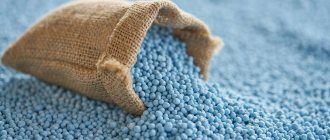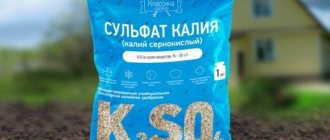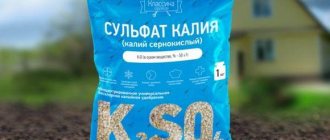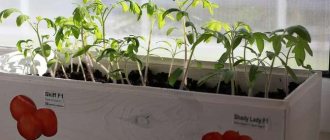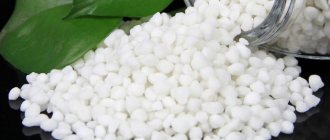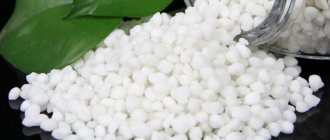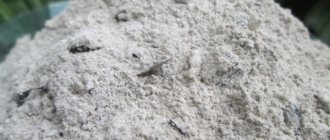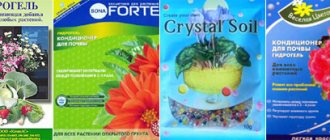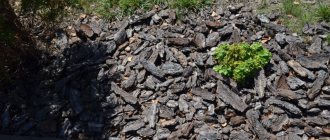Every summer resident wants the planted tomato bushes to grow strong and strong, to increase a sufficient amount of vegetative mass, to bloom actively and form a large number of ovaries, from which a good harvest will grow. However, for this it is not enough to plant the plants in fertile soil, water them and loosen the soil. Tomatoes should be fed during the growth of seedlings and bushes transplanted to a permanent location.
You need to apply fertilizing according to a schedule, since at different stages of growth these vegetables need specially formulated fertilizing. The yield of this vegetable plant depends on how and when the necessary nutrients are added to the soil. In particular, potassium monophosphate is an excellent fertilizer for tomatoes. Why this fertilizer is so useful, how and when it should be applied to tomatoes - this and much more will be written below.
Potassium monophosphate: fertilizer characteristics
Monopotassium phosphate is a mineral fertilizer.
It dissolves in water and is absorbed by the soil in a short time, which provides an immediate effect.
Potassium monophosphate - photo
Fruits and vegetables grown with monopotassium phosphate fertilizer are saturated with sugar even during ripening. It will improve the taste and increase the shelf life of the fruit. Nowadays fertilizing is used in gardens and vegetable gardens, as well as for indoor plants.
Deadlines for depositing
Phosphorus is important at every stage of the tomato growing season:
- During sowing, the seeds are treated with growth stimulants containing phosphorus. This provides the future sprout with resistance to insects and diseases.
- When the first leaves appear and picking is carried out, a solution of water and nitroammophoska grade A is sprayed over the sprouts. The roots develop quickly, the stem strengthens.
- The seedlings are planted in prepared soil (phosphorus-containing compounds are first added to it). This is done in the autumn or during the formation of the bed. When the plants are planted, a dry additive is poured into the hole or a liquid solution is used.
- After 21 days, fertilizing with phosphorus solution is carried out.
- During flowering, you can use bird droppings, manure or nitrophoska. This promotes more ovary production.
Unfertilized soil is fed with a liquid solution before planting. Fertilizer is poured under the bushes as a root feed. This activates the growth of tomatoes.
Composition of potassium monophosphate fertilizer
Potassium monophosphate works when used correctly. The composition of the potassium monophosphate fertilizer is simple, it contains potassium (33%) and phosphorus (50-55%). The presence of two components improves yield and vitamin content. The shelf life of the fruit is also extended.
Important!
The formula for potassium monophosphate is designated as follows: KHPO.
Potassium monophosphate is produced as:
- Powder
- Granule
What does potassium monophosphate look like in the form of granules and powder - photo
Combination with other fertilizers
To increase productivity, agrochemicals are combined. Potassium nitrate is combined with phosphate rock, lime compounds, potassium chloride and potassium sulfates. Phosphorus fertilizer is used for tomatoes with folk remedies - charcoal, bird droppings. Manure is often used with superphosphates, phosphate rock and potassium chloride.
Phosphorus-potassium fertilizers are the best option for tomatoes. Follow the instructions, observe the dosage and add supplements on time. Proper use is the key to high yields.
Potassium monophosphate: mechanism of action and properties
The element potassium is involved in the water-salt metabolism of plants. Potassium increases plant immunity to various infectious diseases, improves the taste of fruits and their saturation with sugars. adds density and elasticity to vegetables.
Properties of potassium monophosphate - video
Phosphorus is an important participant in plant photosynthesis; it promotes more active growth of vegetative mass, improvement of the root system, and formation of ovaries.
Important!
Potassium monophosphate has high solubility in water, which allows plants to receive the most necessary nutrients in the shortest possible time.
Once potassium monophosphate is dissolved in water, a lot of phosphoric acid will be supplied to the plants. Moreover, this does not affect the chemical processes in the soil. The component may not absorb phosphorus. It is present in the soil. Potassium interacts with the soil and is absorbed by crops; it does not accumulate in the ground.
Existing analogues
There are not many analogues of monophosphate. The most similar is the drug produced in Israel - Pekacid. This is a fertilizer with a high content of phosphorus and potassium. Its formula is NPK 0-60-20. Designed for preparing fertilizing solutions through a drip and irrigation system. A distinctive feature is acidity. The solutions have a pH value of 2-2.2, which helps cleanse irrigation systems of bicarbonates. The fertilizer is so acidic that it simply washes away the limescale deposits from the drip system.
The undeniable advantage of the drug is its powerful, fetid odor. When carrying out foliar feeding with weak solutions of pecacid, aphids, mole crickets, cutworms do not approach tomato bushes.
Fertilizer has a high cost, but reviews indicate that it is highly effective in fighting insects and simultaneously feeding.
Advantages and disadvantages
Monopotassium phosphate fertilizer has differences from others, such as monocalcium phosphate.
The benefits of fertilizing include:
- Rapid absorption by soil.
- No harmful components for seedlings.
- Protection from cold during frosts.
- High-quality moistening of dry soil.
- Effective also for all indoor flowers.
- Increasing the number of shoots in young crops.
- Compatibility of potassium monophosphate with pesticides.
- Lack of soil oxidation properties.
- Plant protection from powdery mildew.
Brief overview of potassium monophosphate - video
Many plants require additional feeding. The complex effect can significantly improve productivity.
But monopotassium phosphate also has disadvantages:
- Cannot accumulate in soil.
- Not used to prepare plants for winter.
- Weeds feed on this fertilizer.
- Incompatibility of potassium monophosphate with fertilizers containing calcium and magnesium.
- Not suitable for indoor plants that develop slowly.
Now many factories produce fertilizers. But Bui fertilizers are among the most popular. Optimal composition and efficiency make the products in demand.
Signs of shortage
The lack of important nutrients can be seen with the naked eye.
Main features:
- plant growth slows down;
- the color of the leaves changes from green to dark green, blue, and a purple tint appears;
- if the situation is neglected, the foliage curls and falls;
- shoots become small;
- red blotches and brown spots on the foliage form on the cuttings;
- tomatoes drop their inflorescences;
- There is a delay in flowering, the fruits ripen slowly.
When should you use monopotassium phosphate?
Potassium monophosphate powder and granules can be used as plant nutrition.
This fertilizer is used for:
- Seedlings. During unfavorable weather, the time for planting in open ground is extended. For root formation with limited nutrition, it is advisable to choose root.
- Excellent flowering and reducing the number of fallen ovaries, improving the yield.
- Long-lasting and high-quality flowering.
- Feeding plants with brown leaves.
FERTILIZERS for the garden and vegetable garden!
• Azofoska • Ammofoska • Nitrophoska
Selection rules
If the soil is depleted, it is better to apply fertilizers in the fall, during digging. Insoluble or slightly soluble fertilizers that have a long-lasting effect are suitable for this.
During the growing season of tomatoes, soluble bait is suitable, which is used in dry and liquid form.
When choosing fertilizer, take into account the characteristics of the soil. If the soil is acidic, then using complex fertilizers is not recommended because they contain chlorine. It is better to choose products with potassium sulfate.
Soil characteristics are taken into account when choosing fertilizer
How to use monopotassium phosphate for different crops
First you should familiarize yourself with the rules for using bait. Instructions for using potassium monophosphate fertilizer are indicated on the packaging. It is better to create a solution in small quantities, since its components quickly disintegrate, and after which it will be useless.
There are general rules for diluting potassium monophosphate for seedlings, vegetables, and flowers.
You can prepare a solution based on:
- 10 g of fertilizer is diluted in 10 liters of water - this solution of potassium monophosphate is used for seedlings of various crops;
- 15-20 g per 10 liters of water - this product is used to feed vegetable crops grown in open ground;
- 30 g per 10 liters of water - a solution in this concentration should be used for fruit and berry crops.
Dosage and method of application - photo
According to reviews, the effect of potassium monophosphate is better if foliar sprays are applied to the leaves in the evening. Then the drug does not evaporate for a long period and is able to be absorbed in a short time.
Important!
Potassium monophosphate becomes 30% less effective an hour after creating the solution.
Gardeners highlight another feature of feeding. Wild plants and weeds are highly sensitive to the drug. Therefore, before the procedure, weeding and loosening of the top layer of soil is required.
Potassium monophosphate for seedlings
The use of potassium monophosphate for vegetable and flower seedlings
When creating a solution for irrigation, it is important to maintain the correct concentration. It is created in a ratio of 7-10 g of monophosphate to 10 liters of water. A solution of potassium monophosphate is used for seedlings of flowers and plants.
Potassium monophosphate for strengthening seedlings - video
The first feeding is carried out when the first 2-3 true leaves appear on the seedlings, the second is carried out 2 weeks after picking or planting the seedlings in open ground, the concentration is the same - 7-10 g per 10 liters of water.
Useful article:
How to improve the composition and fertility of the soil in the garden
Tomatoes - feeding with potassium monophosphate
To ensure high-quality feeding of tomatoes, watering with potassium monophosphate should be done no more than 2 times a season. Such actions allow you to get a high-quality harvest. There should be at least 2 weeks between procedures. For this, a 0.15% solution is used. It is advisable to take a quarter of a bucket per bush. 10 liters of solution are used for about 4 adult tomatoes.
Photo of preparation of fertilizing tomatoes with potassium monophosphate
If the year is favorable, the break between waterings will be at least 3 weeks. It is important to consider the pace of plant development. If necessary, between main treatments, foliar spraying is carried out with a solution with a fertilizer concentration not higher than 0.15% of the green part. It is advisable to use a solution with this concentration after heavy rainfall.
Cucumbers - rules for fertilizing potassium and phosphorus
Feeding cucumbers with potassium monophosphate is done by watering them with the solution in the same way as tomatoes. The concentration is the same, but in this case, foliar feeding must be carried out taking into account the type of fruit formation.
Photo of feeding cucumbers with potassium monophosphate using watering solution
During normal fruiting, cucumbers are straight and thick at the base. If they are curved or pear-shaped from the ovary, then this indicates a lack of potassium, so fertilizing in the form of spraying is required. It is preferable to carry out the work before watering. If the cucumbers taste bitter due to a lack of potassium, then it will be too late to perform any procedures.
Potatoes, root vegetables, onions, garlic - fertilizer with potassium monophosphate
Thanks to the use of fertilizers, the harvest will be much better. To do this, spraying is performed. If you water, this will cause an increase in the root system.
Photo of spraying potatoes
The concentration of potassium monophosphate for feeding potatoes, beets, carrots, onions, garlic and other similar vegetables should be 0.1-0.2%. It is advisable to carry out treatment 2 times during the season.
The same rules apply to feeding root crops and bulbous plants.
Interesting article:
Rules for fertilizing strawberries for a good harvest
Berry and fruit trees
To treat trees and shrubs (watering or spraying), a concentrated solution of potassium monophosphate is used: 30 g of the substance is needed for 10 liters of water. Although, according to some instructions for using this product for berry crops, the traditional concentration should be used, 15 g per 10 liters. Be sure to read the instructions and annotations before processing plants!
Photo of spraying a fruit tree
For a bush, the solution consumption is 7-10 liters per square meter. m. Taller trees require 15-20 liters. The use of fertilizing will improve the yield many times over.
Feeding berry bushes and fruit trees with potassium monophosphate is carried out in three stages:
- immediately after flowering;
- 2 weeks after the first;
- in autumn, mid-September.
Useful article:
How to feed raspberries
Potassium monophosphate for flowers
For flowers, fertilizer is used when the buds open. If the year is favorable, the seedlings are watered with a 0.1% solution. The norm is 3-4 liters per square meter. m.
Photo of spraying flowers
If the flowers have 3-4 leaves, then for early flowering they are sprayed with 0.02% potassium monophosphate. Outdoor flowerpots and hanging flowers should be fed, just like ground plantings. Such fertilizers are used for many flowering plants: petunias, tulips, phlox, roses.
Application for grapes
Using one MFC is not enough, and it is not advisable. Because the culture is highly dependent on magnesium. In the second half of their life, the grapes are fed potassium magnesium, which can quickly leach. Therefore, in cool, damp times, preferably in the fall, in September, you can apply a one-time fertilizer, preparing the plant for winter.
Fertilizer can be applied to the grapevine through watering and foliar feeding “on the leaf” in the traditional concentration of 15 g per 10 liters of water.
Water or spray?
Potassium is absorbed into plants much faster when the solution is sprayed over its surface.
But you cannot overdo it with foliar feeding of tomatoes - they do not tolerate excessive moisture in the green mass.
Therefore, potassium must be applied in liquid form at the root, alternating with spraying.
Efficiency depending on soil type
A minimum amount of magnesium fertilizing is required for clay and loamy soils.
In sandy and sandy loam soils, this element is always in short supply, so fertilizing with sulfate-magnesium mixtures is necessary. On such soils, due to their high filtering capacity, the applied nutrients run out within a year after fertilizing. Therefore, it is impossible to do without improving the quality of the soil.
We invite you to read: Why does the body need potassium? — Vitamin and Mineral || Minerals containing potassium promote growth
But, given the increased acidity of sandy soils and sandy loams, when adding magnesium, it is necessary to lime this soil so that other minerals from the nutrient composition can be absorbed by plants without hindrance. The means for this are wood ash, dolomite, chalk, lime. Even dried, finely ground eggshells will do.
If there is black soil on the site, it is not necessary to use magnesium. Chernozem is rich in almost all substances useful for plants, so the procedure for fertilizing with magnesium sulfur can only be done for preventive purposes. The exception is the acidic reaction of the soil, when the pH is equal to or less than 6.0.
LiveInternetLiveInternet
—Categories
- = K U L I N A R I Y = (2489)
- Pancakes and pancakes (57)
- Dishes “KOREAN style” (76)
- Fruit and Berry Dishes (65)
- Baked pork, brisket, ham, pastrami, etc. (61)
- Sandwiches, canapés (47)
- Quick and Tasty LUNCH or DINNER (216)
- Quick and Delicious BREAKFAST (133)
- Dumplings, dumplings, khinkali, manti, etc. (52)
- Side dish (35)
- Stuffed cabbage rolls (14)
- Cooking in a sleeve, foil, etc. (76)
- Cooking in MICROWAVE (45)
- Cooking in a MULTICOOKER (32)
- We prepare for a HOLIDAY, FUCKET, etc. (186)
- Cooking OFF-PRODUCTS (tongue, liver, heart, etc.) (38)
- Cooking with MUSHROOMS (63)
- Dessert: sweets, ice cream, yoghurts, etc. (117)
- For a PICNIC (111)
- in KAZAN at KOSTRA (5)
- Food in pots (34)
- Deep-fry: pasties, belyashi, pies, etc. (80)
- SNACK Rolls and Cakes (81)
- Blanks for future use (SEMI-FINISHED PRODUCTS) (23)
- Goldfish (104)
- Salt the fish (67)
- Casserole (23)
- Greens (10)
- From cheese. (26)
- From stale bread (17)
- From Eggs: dishes, omelettes, brizoli, etc. (37)
- We smoke products (27)
- Cereals. Porridge (16)
- Pockmarked hen (183)
- in LAVASH (60)
- Menu for the week (9)
- Seafood (12)
- Meat and minced meat (263)
- Drinks (67)
- Vegetables (139)
- Recipe from Stalik Khankishiev (17)
- Salads and snacks (350)
- Salo (39)
- YOUR OWN meatloaves, sausages, sausages, etc. (29)
- DIY (butter, cheese, etc.) (64)
- TIPS for cooking (100)
- Sauces, Marinades, Dressings, Gravy (50)
- Spaghetti, Pasta, Noodles (7)
- Soups, lagman, beshbarmak, etc. (38)
- We create from cottage cheese (115)
- Decorating dishes, carving (64)
- STUFFED vegetables, vegetable pancakes, pies, zrazy (68)
- Jellied meat, Jellied (7)
- Food storage (35)
- = BAKER A = (365)
- DOUGH (114)
- Puff pastry (44)
- The Beauty of BAKING (18)
- Bread, Flatbread, Donuts (16)
- Pies (77)
- Pies (67)
- Pizza (34)
- Samsa (5)
- And something else. (88)
- Baking TIPS (35)
- = S L A D E N K O E = (2026)
- DOUGH (87)
- Perfect sponge cake (15)
- The Beauty of BAKING (65)
- TIPS and IDEAS for baking (132)
- Puff pastry (75)
- From SHORT Dough (40)
- CREAM for decorating baked goods (37)
- glaze and fondant (25)
- MASTIC: cooking secrets (10)
- CAKES, sweet PIES (482)
- Cake on a FRYING PAN (35)
- Charlottes / Pies with fruits and berries (177)
- Cheesecakes, Flans, Tarts (74)
- Puff pastries, Croissants, Rolls, Buns (176)
- Cupcakes, Easter cakes, muffins, cupcakes (127)
- Manniki, Cottage cheese, Sour cream (43)
- Cakes, Gingerbread, Eclairs (115)
- Cookies, Gingerbread, Meringue, Shortcakes (237)
- Nuts, Donuts, Donuts, Bagels (54)
- Rolls (83)
- Sochni (7)
- Cheesecakes (13)
- Brushwood, baursaks, chak-chak (15)
- NO BAKE (277)
- Dessert (candies, bars, etc.) (127)
- Waffles (3)
- Collection of recipes (33)
- Confectionery equipment (10)
- = Z A G O T O V K I for Z I M U = (254)
- Important! (17)
- Freeze (27)
- Adjika, ketchup, sauces (20)
- Cucumbers, tomatoes, cabbage (58)
- Zucchini, eggplant, peppers, etc. (thirty)
- From fruits and berries (90)
- Salad for the winter (5)
- Greens (3)
- Mushrooms for the winter (24)
- = K U X N I = (210)
- TABLEWARE (use and care) (54)
- Putting the KITCHEN IN ORDER (64)
- OWN: liquid soap, sprays, etc. (22)
- Fridge. Microwave oven (care, unusual uses) (15)
- Kitchen FURNITURE (34)
- Useful in the KITCHEN (41)
- = U Y T in D O M E = (982)
- Bathhouse (23)
- We knit (socks, mittens and something else. ) (25)
- Hassle-free ironing (18)
- Decoupage and decor (298)
- We make furniture beautiful (covers, capes, etc.) (16)
- For the soul: decorating the house (and garden) with crafts (92)
- Let's tie a scarf and tie (26)
- Interior (108)
- Rugs (16)
- Something about FOOTWEAR (31)
- Beauty for walls (wallpaper, stencils, etc.) (50)
- OWN sprays, liquid soap, bleaches, etc. (39)
- Serving and etiquette (8)
- Cleaning WITHOUT chemicals (66)
- Smart cleaning (79)
- Chemical cleaning at home (90)
- Clean washing in a clean washing machine (104)
- = USEFUL - BAD TIPS = (163)
- Home Economics (77)
- Under the LAW (Family Matters) (48)
- Miscellaneous (42)
- Useful on the go (3)
- = CUT and SEW = (617)
- Building a PATTERN (34)
- TIPS for seamstresses (90)
- Blouses, tunics, cardigans, etc. (89)
- Dresses, robes, etc. (74)
- Pants, skirts (50)
- Lingerie and Swimwear (22)
- And something else. (6)
- Minor clothing repairs (21)
- Repurpose old things (75)
- Bed linen (25)
- Curtains (tailoring, collections) (112)
- Bags and wallets (41)
- Tips for LADIES (100)
- From fabric scraps (27)
- = HOMEHOUSE = (1524)
- Gardener's CALENDAR (59)
- SEEDLING: soil mixtures, sowing and care (176)
- Review and characteristics of vegetable seeds and fruits (70)
- Fertilizers, Fertilizers, Growth stimulants (254)
- Tools, accessories for seedlings and garden (51)
- Greenhouses, greenhouses, beds (137)
- Watering (69)
- Useful tips for the garden (44)
- Tips from Igor Lyadov (6)
- Weeds, Pests, Plant Diseases (194)
- Tomatoes (341)
- Cucumbers (214)
- Onion and Garlic (140)
- Berry (131)
- Berry bushes (92)
- Orchard (92)
- Greens (10)
- Legumes and Other Vegetables (11)
- Bakhcha (38)
- Cabbage (25)
- Potatoes and Root Vegetables (73)
- Compost (17)
- Lawn (4)
- Mushrooms (5)
- Vegetable harvesting (1)
- Storing vegetables and fruits (22)
- = COLORS = (777)
- Sowing flowers for seedlings: soil mixtures and seeds (107)
- Annuals (45)
- Biennial garden flowers (12)
- Perennials (sowing, care, propagation, advice) (77)
- Bulbous perennials (51)
- Lilies (22)
- Peonies (24)
- Phlox (10)
- Roses (118)
- Lianas (Clemates, Kobeya, etc.) (42)
- Ampelous flowers (106)
- Petunias (123)
- Eustoma (9)
- Fuchsia (23)
- Pelargonium (Geranium) (26)
- Shrubs in the garden (4)
- General tips for flower growers (56)
- Watering and fertilizing flowers (85)
- Flowerpots, pots. (36)
- Flower beds, flower beds, rock gardens (64)
- = M A S T E R A M = (482)
- We do it ourselves for home and garden (182)
- We make furniture (89)
- Remodeling and decorating old furniture (35)
- We will build a grill, barbecue, barbecue ourselves (36)
- About tiles and concrete blocks (23)
- We'll do the repairs ourselves (80)
- We repair equipment (7)
- Plumber (9)
- COLLECTION OF TIPS (20)
- Builder (54)
- Electrician (13)
- Fisherman (3)
- = HEALTH = (652)
- Sore feet . (47)
- Instead of tablets (healing properties of honey and plants) (97)
- Headache, Stroke, Heart Attack (3)
- Stomach and. etc. (12)
- Getting rid of BAD habits (32)
- Beauty is a terrible force (107)
- Did you call an ENT specialist?! (Ear, nose, throat) (34)
- We increase IMMUNITY (and cleanse the body a little). (48)
- Spine, neck and joints (126)
- Liver, Kidneys, Urinary. (26)
- Cold ? Yes . but it's NOT a TROUBLE! (56)
- DOCTOR'S advice (9)
- MISCELLANEOUS (People's Councils) (142)
- Tablets and ointments (57)
- = TIPS FOR PARENTS = (158)
- General Tips (90)
- For Schoolboy (72)
- = D E T Y M = (145)
- Games (85)
- Cartoons and films (64)
- = I N T E R E S N O = (1280)
- Rus, Russia, Russian language (11)
- Online (cinema and more) (140)
- WOW (WoW). (9)
- Age-old wisdom (25)
- Vesyolenkoe (349)
- Date of birth, names, horoscopes (70)
- For SMS and congratulations (48)
- BEAUTY (267)
- Music, songs (97)
- A little bit about everything (127)
- SUPER - dancing (60)
- Believe it or not, believe it or not. (86)
- = For D N E V N I K A = (111)
- "with Codes" (4)
- Anime and Decorations (7)
- Tips (24)
- Schemes (72)
- = ELECTRONIC LIBRARY = (7)
Positive sides
Professionals advise giving preference to the drug in granular form. There are reasons for this. The granules can be dissolved and mixed with any water - both from a local well and from a tap, well, or stream. But with powder it’s not so simple. If too hard water is used during mixing, the potassium monophosphate will sinter.
If it is possible to manually process the plantings, then farmers are always advised to use such fertilizer. This method is especially justified in areas of medium or small area. Although the drug is not so cheap, in the future all costs will be more than offset by a bountiful harvest. If we compare it with another popular fertilizer - superphosphate, then monophosphate is several times higher in concentration of chemical elements.
Interestingly, such a preparation can be made independently from ash and phosphoric acid. This takes time, but the process itself is simple: you need to collect ash in a half-liter jar, pour it into a suitable container, pour in a liter of warm water, mix and leave for a couple of hours. Then pour into a jar, being careful not to disturb the sediment, and add acid little by little until carbon dioxide ceases to be released. After this, you can make a working solution.
Pros of use:
- increases the frost resistance of plants, makes them stronger and more resistant to parasites and diseases;
- helps to get a decent harvest;
- promotes the formation of side shoots with peduncles (especially important for flowering annuals and perennials);
- prevents premature aging of plants (meaning wilting of flowers and falling leaves);
- easily transported in plant tissues and easily absorbed by foliage, stems, branches, roots;
- can be used in combination with any pesticides (many gardeners prepare general mixtures for processing and fertilizing);
- does not affect soil acidity;
- creates favorable conditions for soil microorganisms involved in soil structuring (which is especially important for greenhouse owners who often experience drying out);
- helps save on watering;
- does not accumulate harmful substances in the soil;
- fights and prevents the occurrence of powdery mildew and other diseases.
One of the most important positive qualities is that it is impossible to overfeed the plantings with such fertilizer.
Features of application
The effectiveness of superphosphate strongly depends on the acidity of the soil. It is absorbed well in alkaline and neutral conditions, but a low pH level blocks the entry of the element into plant organisms.
Double superphosphate is less sensitive to soil acidification than simple superphosphate.
In order for the fertilizer to work on acidic soil, it should be limed - applied for digging or plowing:
- chalk;
- lime;
- ash;
- dolomite flour.
Liming and the application of phosphorus fertilizers must be separated in time as far as possible. That is, done in different years. Many sources recommend deoxidizing the soil at least a month before filling with superphosphate. This is not enough: the active substance begins to work, although not at full strength, but part of it is still converted into a form inaccessible to plants.
Other recommendations:
- dry fertilizer should not be scattered over the surface, but embedded in the soil closer to the roots of the plants;
- Calcium should not be added at the same time as simple superphosphate - there is already enough of it, and excess Ca will return P to a sparingly soluble state;
- To quickly replenish the element, you should use a hood and process the tomato leaf by leaf.
Superphosphate, except calcium-containing ones, cannot be used simultaneously with the following fertilizers:
- urea;
- ammonium nitrate.
Together with the drug you can use:
- other nitrogen fertilizers;
- rotted humus (tomatoes cannot tolerate fresh manure);
- potash fertilizers.
No precautions are needed when working with superphosphate - it is fire and explosion-proof
Secrets that many people don't know about
Regardless of the size of the picking pots, they must be placed on 1 square. m. no more than 12-14 plants. This will bring the bushes closer to reality, maintaining healthy competition (like in a garden bed).
By planting in small pots and keeping the plants there until planting in the soil on the site, we destroy the measles system. It develops until it fills a lump of soil around the perimeter. Then growth stops and the plant experiences stress. The result is a decrease in yield even with good inclinations (proven variety).
Potassium is also used during the fruiting period. How does he work? The element provokes the outflow of sugars and carbohydrates from greens to fruits. Therefore, fertilizer is used when feeding tomatoes both after picking and during fruiting.
Important points for correct picking
Seeding is carried out in cassette cells. After 4-5 leaves appear, you can dive into pots. The optimal volume for low and medium-sized varieties of tomatoes is 400 ml. In smaller glasses, the root system will not develop sufficiently. And a large container will take up extra space, which is always in short supply at home. In this case, pots with a volume of 500-600 ml. will be ideal for early varieties that need to be replanted into the ground later. Or when growing tomatoes in regions with long winters.
